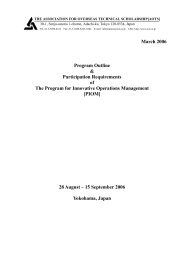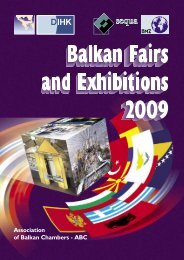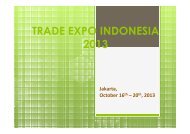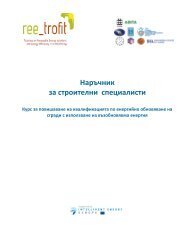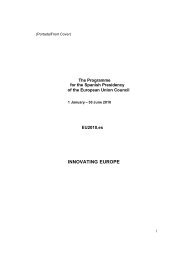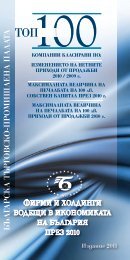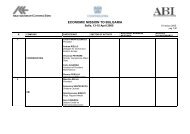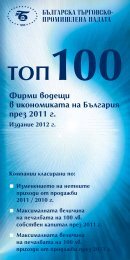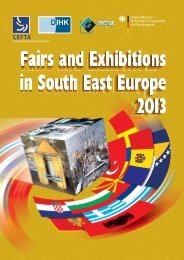Analysis of the Operation and Financial Condition of the Enterprise
Analysis of the Operation and Financial Condition of the Enterprise
Analysis of the Operation and Financial Condition of the Enterprise
Create successful ePaper yourself
Turn your PDF publications into a flip-book with our unique Google optimized e-Paper software.
<strong>Analysis</strong> <strong>of</strong> <strong>the</strong> <strong>Operation</strong> <strong>and</strong> <strong>Financial</strong> <strong>Condition</strong> <strong>of</strong> <strong>the</strong> <strong>Enterprise</strong> Underst<strong>and</strong>ability One <strong>of</strong> <strong>the</strong> most characteristic features <strong>of</strong> <strong>the</strong> informationpresented in <strong>the</strong> financial statements is its underst<strong>and</strong>ability. Therefore it isassumed that <strong>the</strong> users <strong>of</strong> financial reports have a good business, economy <strong>and</strong>accounting knowledge toge<strong>the</strong>r with <strong>the</strong> willingness to study this informationwith due care. Relevance In order for <strong>the</strong> information to be useful it should correspond to<strong>the</strong> needs <strong>of</strong> decision-taking by users. Information is relevant if it influences <strong>the</strong>adoption <strong>of</strong> business decisions as follows: provides <strong>the</strong> assessment <strong>of</strong> <strong>the</strong> past,present or future events, or ei<strong>the</strong>r confirms or corrects <strong>the</strong> previous assessmentsmade <strong>of</strong> <strong>the</strong>se events. In order for <strong>the</strong> information to have <strong>the</strong> forecasting value itshould not always be strongly expressed as a forecast. However, <strong>the</strong> layout <strong>of</strong>providing <strong>the</strong> information about past transactions <strong>and</strong> o<strong>the</strong>r events influences <strong>the</strong>usefulness <strong>of</strong> reports on issues <strong>of</strong> forecasting. Information is relevant ifavoidance or alteration <strong>of</strong> this information might affect <strong>the</strong> business decisionstaken by <strong>the</strong> users <strong>of</strong> financial statements which <strong>the</strong>y have adopted based on thisstatement. Reliability Information must be reliable to be useful. Information is reliableif it is free from material error <strong>and</strong> bias. It must represent faithfully <strong>the</strong>transactions <strong>and</strong> o<strong>the</strong>r events that it should or is reasonably expected to represent.Representation according to substance: transactions should be represented notonly according to its legal form, but also according to its substance <strong>and</strong> economicreality. Completeness – information must be complete to be reliable. Comparability Users must be provided with <strong>the</strong> possibility to compare anenterprise’s financial statements through time to identify <strong>the</strong> trends <strong>of</strong> itsfinancial status <strong>and</strong> performance results. This means that <strong>the</strong> evaluation <strong>and</strong>presentation <strong>of</strong> <strong>the</strong> financial effects <strong>of</strong> like transactions <strong>and</strong> events should becarried out consistently within <strong>the</strong> enterprise.Constraints to information relevance <strong>and</strong> reliability are as follows: Timeliness Information may become irrelevant if <strong>the</strong>re is a delay in reportingit. In order to report information on a timely basis it is <strong>of</strong>ten necessary to provideit before all aspects <strong>of</strong> <strong>the</strong> transaction or any o<strong>the</strong>r event are known, thuscompromising reliability <strong>of</strong> information. In order to find a balance betweenrelevance <strong>and</strong> <strong>the</strong> provision <strong>of</strong> reliable information, <strong>the</strong> overriding considerationis how best to satisfy <strong>the</strong> economic decision-making needs <strong>of</strong> <strong>the</strong> users. Balance between benefits <strong>and</strong> costs The benefits derived from anyinformation must exceed <strong>the</strong> costs <strong>of</strong> presenting this information.3.2. Description <strong>of</strong> <strong>the</strong> main balance sheet itemsBalance sheet is a report prepared on <strong>the</strong> basis <strong>of</strong> <strong>the</strong> books <strong>of</strong> accounting reflecting<strong>the</strong> financial position <strong>of</strong> <strong>the</strong> business at a particular moment. Balance sheet has twocomponent parts: The figures disclosed under assets show <strong>the</strong> amounts <strong>and</strong> <strong>the</strong> types <strong>the</strong>resources possessed by an enterprise are classified;49



